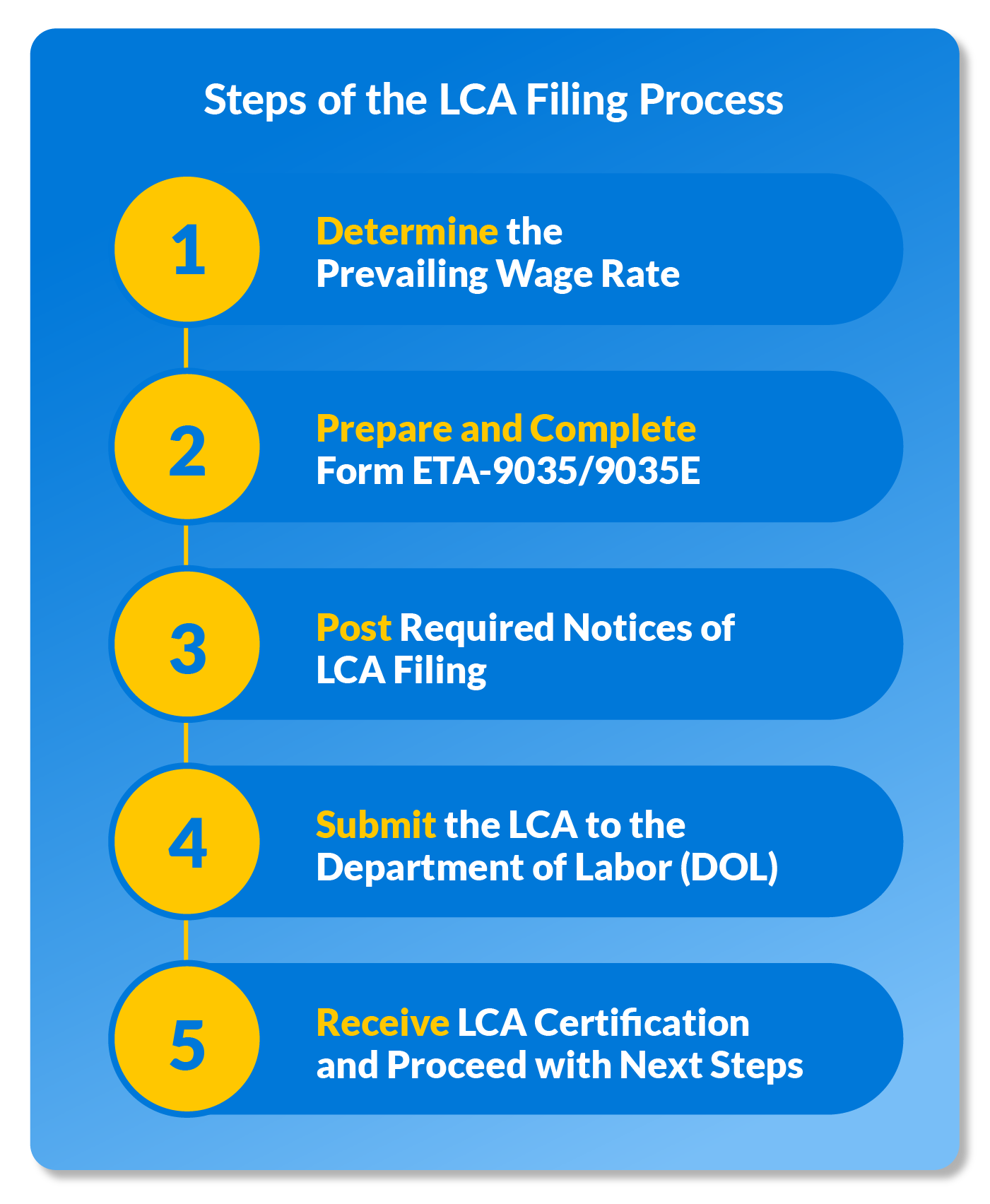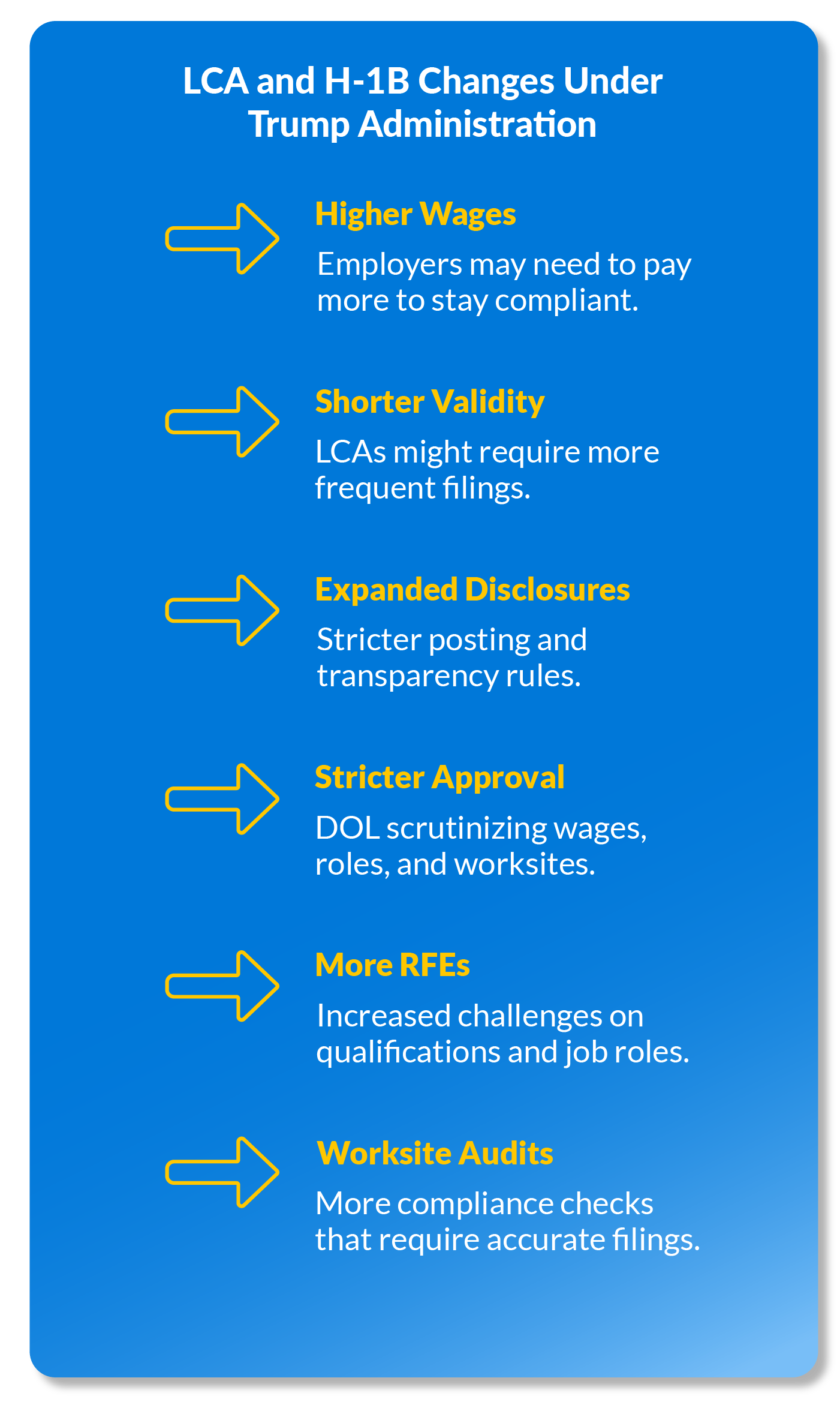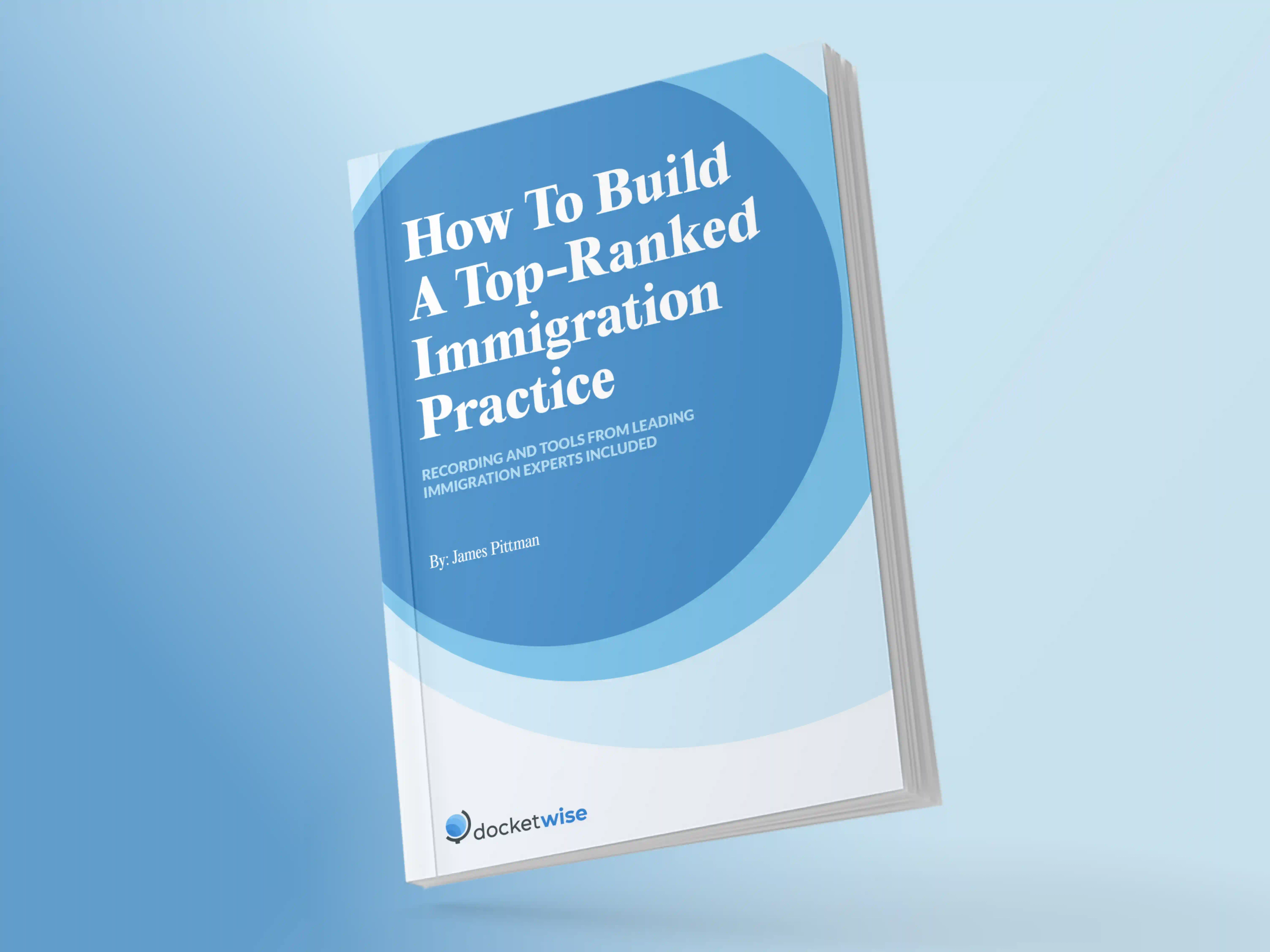A Labor Condition Application (LCA) is a document required by the Department of Labor (DOL) before an employer can sponsor a foreign national under certain work visas—most commonly the H-1B. In the H-1B process, the employer must attest in the LCA that they are offering the foreign worker the prevailing wage (or higher) for the position and will provide working conditions that do not adversely affect other employees.
Essentially, the LCA serves as a means of:
Legal compliance: It confirms that the employer meets wage and working condition standards.
Protection for U.S. workers: By establishing prevailing wage requirements, the LCA helps ensure that hiring a foreign national won’t undercut wages or opportunities for U.S. employees.
Since the LCA is a legal attestation, many employers rely on immigration attorneys or law firms to handle the process. Immigration legal professionals do the following:
Ensure Compliance: Reviews job details and prevailing wage data to confirm that the employer is offering at least the required wage under DOL standards.
Prepare and File the LCA: Completes Form ETA-9035 on behalf of the employer via the DOL’s Foreign Labor Application Gateway (FLAG) system.
Manage Posting Requirements: Advises the employer on properly posting the required notices at the worksite to inform employees of the filing.
Handle LCA Audits & Issues: If the DOL audits the employer or flags issues in the LCA, the attorney assists with responses, corrections, and documentation.
Coordinate with the H-1B Petition: Ensures the approved LCA is included in the Form I-129 filing with USCIS, a key step in the overall H-1B petition process.
Filing an LCA accurately and on time is critical. Any mistakes can delay the broader H-1B petition, creating complications for both the employer and the prospective employee. Employers often retain lawyers to prepare and file LCAs and advise them on compliance measures to maximize the chances of having LCAs and subsequent visa petitions approved.
Steps in the LCA Filing Process
While the LCA process may seem straightforward, even minor errors can derail an application or lead to compliance issues. So let’s go over each of the steps carefully.

Step 1: Determine the Prevailing Wage Rate
The first step in LCA filing is to determine the correct prevailing wage for the position. The DOL uses several sources to calculate the appropriate wage level, including:
National Prevailing Wage Center determinations
The OFLC Wage Search database
Independent wage surveys
Collective bargaining agreements
Choosing the right wage source is essential for compliance—incorrect wage data often triggers application delays or denials.
Step 2: Prepare and Complete Form ETA-9035/9035E
Form ETA-9035/9035E is the official LCA document you submit to the DOL. You’ll need to provide details about:
The employer (FEIN, address, contact information)
Job title, duties, and location
The prevailing wage and actual wage
Employer attestations regarding wages, working conditions, and notice posting
Accuracy here is key. Any mistakes on this form can significantly affect LCA processing time.
Step 3: Post Required Notices of LCA Filing
Before filing, employers must post two notices of the LCA filing at the worksite or provide electronic notice to affected employees. This requirement ensures transparency for U.S. workers who might be affected by the hiring of a foreign national.
Step 4: E-Filing the LCA to the Department of Labor (DOL)
After you’ve posted the required notices, you can submit the LCA electronically via the DOL’s Foreign Labor Application Gateway. You'll be prompted to provide information such as the visa classification, employer details, attorney or agent information (if applicable), job specifics (including title, description, location, and wages), and attestations regarding compliance with labor condition statements.
Step 5: Receive LCA Certification and Proceed With Next Steps
Once the DOL approves your LCA, you’ll receive a certified copy. At this stage, you can file the Form I-129 petition (provided the foreign national’s registration was selected in the H-1B lottery, if applicable). The certified LCA must be included with the H-1B petition documentation.
LCA Processing Times
Generally, the DOL processes electronically filed LCAs within 7 to 10 business days. During peak H-1B filing seasons, however, processing can take longer. There is no official “expedited” path for LCAs akin to premium processing for H-1B petitions, so planning ahead is essential.
That being said, high application volume, public holidays, and errors in your submission can extend LCA processing time. By double-checking your application and submitting all required documentation, you can minimize potential delays.
Immigration lawyers should proactively communicate with their clients about these timelines—especially during busy H-1B filing windows. Setting realistic expectations helps avoid confusion and stress if approvals take longer than anticipated.
Documents Required for LCA Filing
Accuracy is crucial. Having the right documents required for LCA filing ensures a smoother process and helps avoid Requests for Evidence. Key items include:
Form ETA-9035/9035E
Proof of prevailing wage determination (e.g., wage survey results or official DOL data)
Employer attestations (confirming wage, notice posting, and other compliance requirements)
Documentation of worksite location(s) (particularly important if the beneficiary will work at multiple sites)
Keep a well-organized record of these LCA immigration documents. Proper documentation reduces errors and supports faster review by the DOL.
Potential Impacts to the LCA and H-1B Process Under the Trump Administration
The Trump Administration introduced several policy shifts that impacted LCA filing and the broader H-1B process. While some initiatives may evolve under different administrations, they highlight the importance of vigilance:

Higher prevailing wage requirements. Employers may need to pay higher wages to remain compliant.
Shortened certification validity periods. LCAs could be approved for a shorter duration, requiring more frequent filings.
Expanded public disclosure requirements. More detailed postings and disclosures might be needed to remain compliant.
Revised criteria for LCA approval. The DOL more closely scrutinized position requirements, wages, and worksites.
Increased likelihood of Requests for Evidence. Adjudicators often questioned a beneficiary’s qualifications or whether the role was a specialty occupation.
Expanded worksite visits. Compliance checks became more common, stressing the need for accurate filings and robust documentation.
Staying informed and preparing clients for possible scrutiny or additional documentation requests can help prevent delays.
Common Issues and Delays in LCA Filing Immigration Lawyers Face
Even minor errors in wage data, job classification, or documentation can delay approvals and trigger DOL scrutiny. To streamline filings, immigration lawyers should verify details, leverage case management tools, and maintain organized records.
Incorrect wage data. Using outdated or incorrect wage levels often results in denials or re-filings.
Mischaracterized job duties. Inaccurately describing position responsibilities or selecting the wrong occupational classification can trigger questions from the DOL.
Incomplete documents. Missing or insufficient evidence—like lacking a proper notice posting—slows the process.
Technical errors during e-filing. System glitches or form-fill mistakes can cause rejection or delayed processing.
Solutions to avoid delays:
Double-check all wage determinations, form inputs, and supporting evidence before submission.
Use a reliable case management platform to automate reminders and ensure complete, accurate data entry.
Maintain organized digital records, especially if you need to refile or provide additional documentation.
Tracking the LCA Filing Status as an Immigration Attorney
Monitoring LCA filing status helps you keep clients updated and mitigate surprises. Here’s how to do it effectively:
Access the DOL’s iCERT or FLAG Portal. You can log in to review case updates using your account credentials.
Check status messages. Common statuses include “Submitted,” “In Process,” “Certified,” or “Denied.”
Interpret timeframes. If your application remains “In Process” longer than the typical 7 to 10 business days, you may need to contact the DOL to confirm there are no issues.
Communicate with clients. Provide regular updates—particularly if there are delays—to set realistic expectations.
Track within your software. Many immigration-specific platforms allow you to track LCAs in real-time, automatically updating clients via email or portal notifications.
Benefits of E-Filing With Case Tracking Software
Immigration lawyers increasingly turn to e-filing tools to streamline LCA submissions and track LCA processing time. With so many different processes to manage and so many documents, it can be inefficient to manage document filing between various platforms.
Many immigration lawyers are now turning to solutions that allow them to submit immigration forms right from the same software that they use for case tracking and document management. Integrating these workflows allows for improved efficiency and better processes.
Here are some of the ways that e-filing inside of case management software helps immigration law firms:
Streamlined workflows. Automation can populate form fields, reducing manual errors and time spent on data entry.
Centralized tracking. All client documents, deadlines, and statuses appear in one dashboard, simplifying follow-ups.
Fewer errors and delays. Built-in compliance checks can flag inconsistencies before submission—helping to avoid rejections.
Better client communication. Automated notifications keep clients informed, cutting down on status inquiries.
Especially for immigration lawyers handling multiple LCAs, e-filing within case management software helps maintain consistent, high-quality work while reducing stress.
How Docketwise Enhances the LCA Filing Process
Docketwise streamlines the e-filing process by integrating directly with USCIS, DOL FLAG, and DOS CEAC systems through its Smart Forms feature. This allows immigration attorneys to electronically gather information and submit petitions seamlessly. The process eliminates cumbersome paperwork and improves efficiency by automating data entry and submission.
Docketwise’s e-filing capability helps law firms process applications faster while maintaining compliance with agency requirements. This includes:
Automated forms and integrated tracking. Docketwise auto-populates required forms like ETA-9035/9035E, ensuring consistency and reducing manual input errors.
Compliance tools. Track crucial deadlines—like prevailing wage determinations or notice-posting requirements—and receive alerts before anything slips through the cracks.
Real-time client collaboration. Secure portals let you gather documentation and communicate with clients without juggling multiple platforms.
Integration with LaborLess. LaborLess is a dedicated LCA compliance platform that works seamlessly with Docketwise, making it easier to post notices, monitor public access files, and stay compliant.
Together, these features save time and minimize the risk of errors—letting you focus on providing top-tier legal services rather than chasing paperwork. If you’re an immigration lawyer or firm aiming to improve your LCA filing workflow, schedule a demo to see how Docketwise can help.
Unlock Your Success as an Immigration Lawyer.
Download Now
About the author

Justin FisherContent Writer
Justin Fisher is a content writer and SEO strategist for leading legal software companies, including MyCase, Docketwise, and CASEpeer. He specializes in writing about emerging legal technology, financial wellness for law firms, and more.
